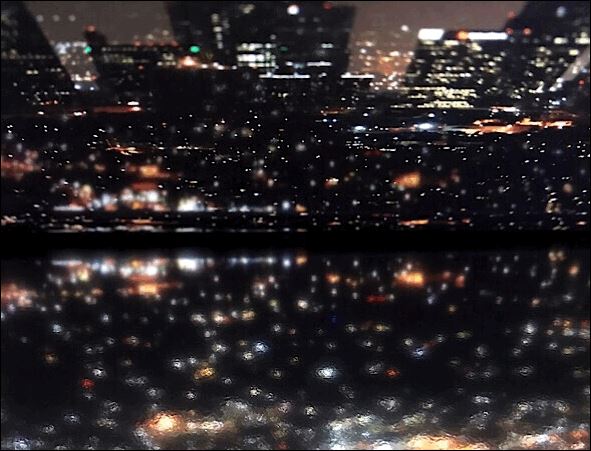4 minutes reading time
(859 words)
Review: FLAX’s The Dialectic of the Stars Bodies 2

Review
Dance
Beyond The 805
The penultimate evening of FLAX’s The Dialectic of the Stars Bodies2 features choreographer and dancer Noé Soulier. Fabien Danesi, the curator of the series, describes LA as “both cinematographic and paradisiac, but also artificial”. His inspiration for The Dialectic of the stars draws a star in Los Angeles: a place of contradiction, hallucination and mystery, at once “political and poetic.” I keep his portrait of Los Angeles at the forefront as he introduces Soulier.
The dance begins with Soulier speaking. As an audience member that has seen Soulier’s previous work, this is not surprising. I am only surprised by the quiet of the room, how loud the cars sound outside, the tonalities of the dancer’s steps amplifying through the floor boards. A dancer that speaks during choreography can sometimes elicit an eyeroll. Why go to see a dancer speak in a dance when I can go to see an actor speak in a play? is a trite protest. But Soulier’s conversation is not contrived; it remains authentic and natural through the entirety of the piece. Soulier’s ability to remain utterly himself in a performative setting is where Danesi’s theme of contradiction shines through. Soulier is at once professor, philosopher, patron, and performer.
Soulier’s use of speech and movement corroborates Danesi’s portrait of LA in a way so metaphysical and ephemeral, one can almost miss it. Soulier is simultaneously a dancing body and a pedestrian body, performer and lecturer. His ability to transition between speech and movement is so seamless I forget how differently the two modes actually function. Soulier makes the distinction between that which is moving and that which leads to movement, but then proceeds to define himself as what is acting and what is undergoing the action. He makes contradictions, and his movements sometimes clarify, but often I am left wondering their purpose.
Soulier then identifies “the spectator of the scene in which you are involved”-- us, the audience. Like the dialectic of the stars, Soulier connects the lines between what we feel and what we know. Soulier’s self-reflexivity both maintains and transforms our relationship of audience and subject. Now, we are aware that he is aware that we are aware-- of the space, of the performance, of the infinitesimal movements that comprise our situation. Similar to Danesi’s depiction of a blurry, hallucinatory LA, Soulier’s performance asks the viewer what it is they are witnessing. What are the boundaries of real life and performance? Performer and person? Imagination and reality? Self-awareness arrives and departs swiftly throughout the piece. Eventually we are a conglomeration of bodies, swaying in the lobby of our conversation.
Soulier gestures from shoulder to wrist, wrist to elbow, elbow to shoulder. He makes geometrical patterns in the body and through the space the body fills. I expect these patterns to disintegrate as soon as he is still again, but they remain. His speech and his movement draw parallels; one always reinforcing and supporting the other. Soulier’s adherence to geometry forces me to consider my own interpretations of the anatomical body. With speech and movement working in tandem, I am aware of the body as a multitude: container, context, producer, transporter, cultural constructer, instrument.
In the wake of these revelations, I wait for some shocking moment to exemplify the ephemerality that he so often addresses. There are bold statements, cliffnote references to prominent choreographers like Brown and Forsythe, and Soulier certainly demonstrates the physicality to prove his points, but the pathos is missing. The idea is there, but for me, the dance lacks a moment of impact on the audience, the moment that separates dance performance from a lecture about dance performance. I want the two to collide and interact, to turn dance on its head-- to make the contradictions that Soulier explains into something new.
We watch Soulier say this and do this. “I’m not doing the action only for the task but for you to see them.” The focus shifts from Soulier to all of the bodies for which he is dancing, returning to the why. True to the mission of LA dance project, Soulier’s performance advocates for dance as not just art form, but as a way of being in the world-- leaning into the contradictions that define us, as individuals, as artists, as a city.
FLAX PRESENTS ‘THE DIALECTIC OF THE STARS’
A SERIES OF ART ACTIVATIONS THROUGHOUT LOS ANGELES
Visual and Performing Arts Festival Brings Together French and American Artists
at a Constellation of Venues for Cross-Cultural Collaboration
The Dialectic of the Stars, a series of video, performance, and music-based programs, showcased at iconic Los Angeles venues this past February 2018 before heading to Paris later in the year. Under the direction of visionary French curator Anna Milone, FLAX has engaged art historian and curator Fabien Danesi, as their Curator-in-Residence to present The Dialectic of the Stars, featuring works by 19 emerging and established French and American artists and collectives. Free and open to all, the pioneering initiative underscores FLAX's mission of promoting mutual understanding between SoCal and France through the arts.
Related Posts
Comments
No comments made yet. Be the first to submit a comment

